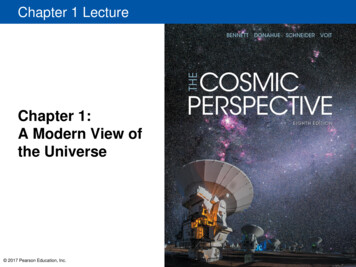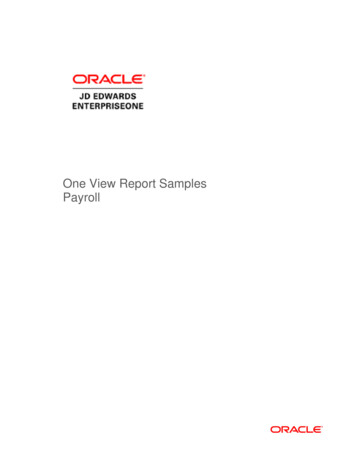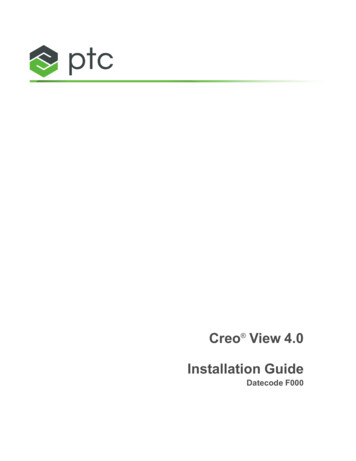
Transcription
Chapter 1 LectureChapter 1:A Modern View ofthe Universe 2017 Pearson Education, Inc.
A Modern View of the Universe 2017 Pearson Education, Inc.
1.1 The Scale of the Universe Our goals for learning: What is our place in the universe? How big is the universe? 2017 Pearson Education, Inc.
What is our place in the universe? 2017 Pearson Education, Inc.
Star A large, glowing ball of gas that generates heatand light through nuclear fusion 2017 Pearson Education, Inc.
PlanetMarsNeptune A moderately large object that orbits a star; itshines by reflected light. Planets may be rocky,icy, or gaseous in composition. 2017 Pearson Education, Inc.
Moon (or Satellite) An object that orbits a planetGanymede (orbits Jupiter) 2017 Pearson Education, Inc.
Asteroid A relatively small and rocky object that orbits astarEros, an asteroid 2017 Pearson Education, Inc.
Comet A relatively small and icy object that orbits astar 2017 Pearson Education, Inc.
Solar (Star) System A star and all the material that orbits it, includingits planets and moons 2017 Pearson Education, Inc.
Nebula An interstellar cloud of gas and/or dust 2017 Pearson Education, Inc.
Galaxy A great island of stars in space, all heldtogether by gravity and orbiting a commoncenterM31, the great galaxyin Andromeda 2017 Pearson Education, Inc.
Universe The sum total of all matter and energy; that is,everything within and between all galaxies 2017 Pearson Education, Inc.
Far away means back in time? Light travels at a finite speed (300,000 km/s).DestinationLight travel timeMoon1 secondSun8 minutesSirius8 yearsAndromeda Galaxy2.5 million years Thus, we see objects as they were in the past:The farther away we look in distance, thefurther back we look in time. 2017 Pearson Education, Inc.
Far away means back in time?Example: We see the Orion Nebula as it looked 1500years ago. 2017 Pearson Education, Inc.
Far away means back in time?Example: This photo shows theAndromeda Galaxyas it looked about 21/2 million years ago. Question: When willwe be able to seewhat it looks likenow? 2017 Pearson Education, Inc.
Light-year The distance light can travel in 1 year About 10 trillion kilometers (6 trillion miles) 2017 Pearson Education, Inc.
Light-year At great distances, we see objects as they werewhen the universe was much younger. 2017 Pearson Education, Inc.
How far is a light-year?1 light-year (speed of light) (1 year)km ö æ 365 days 24 hr 60 min 60 s öæ ç 300,000 çs ø è 1 yr1 day1 hr1 min øè 2017 Pearson Education, Inc.
How far is a light-year?1 light-year (speed of light) (1 year)km ö æ 365 days 24 hr 60 min 60 s öæ ç 300,000 ç s1yr1day1hr1minèø èø 9,460,000,000,000 km 2017 Pearson Education, Inc.
Can we see the entire universe? 2017 Pearson Education, Inc.
Thought QuestionWhy can't we see a galaxy 15 billion light-yearsaway?(Assume the universe is 14 billion years old.)A. Because no galaxies exist at such a greatdistance.B. Galaxies may exist at that distance, but their lightwould be too faint for our telescopes to see.C. Because looking 15 billion light-years awaymeans looking to a time before the universeexisted. 2017 Pearson Education, Inc.
Thought QuestionWhy can't we see a galaxy 15 billion light-yearsaway?(Assume the universe is 14 billion years old.)A. Because no galaxies exist at such a greatdistance.B. Galaxies may exist at that distance, but their lightwould be too faint for our telescopes to see.C. Because looking 15 billion light-years awaymeans looking to a time before the universeexisted. 2017 Pearson Education, Inc.
What have we learned? What is our place in the universe? Earth is part of the solar system, which is theMilky Way Galaxy, which is a member of theLocal Group of galaxies in the LocalSupercluster. 2017 Pearson Education, Inc.
How big is Earth compared to our solarsystem?Let's reduce the size of the solar system by afactor of 10 billion; the Sun is now the size of alarge grapefruit (14 cm diameter).How big is Earth on this scale?A.B.C.D.an atoma ball pointa marblea golf ball 2017 Pearson Education, Inc.
How big is Earth compared to our solarsystem?Let's reduce the size of the solar system by afactor of 10 billion; the Sun is now the size of alarge grapefruit (14 cm diameter).How big is Earth on this scale?A.B.C.D.an atoma ball pointa marblea golf ball 2017 Pearson Education, Inc.
The Scale of the Solar System On a 1-to-10-billion scale: The Sun is the size of a large grapefruit(14 cm). Earth is the size of a ball point, 15 metersaway. 2017 Pearson Education, Inc.
How far away are the stars?On our 1-to-10-billion scale, it's just a few minutes'walk to Pluto.How far would you have to walk to reach AlphaCentauri?A.B.C.D.1 mile10 miles100 milesthe distance across the United States(2500 miles) 2017 Pearson Education, Inc.
How far away are the stars?On our 1-to-10-billion scale, it's just a few minutes'walk to Pluto.How far would you have to walk to reach AlphaCentauri?A.B.C.D.1 mile10 miles100 milesthe distance across the United States(2500 miles) 2017 Pearson Education, Inc.
How big is the Milky Way Galaxy? The Milky Way has about 100 billion stars. On the same 1-to-10-billion scale, how big isthe Milky Way? 2017 Pearson Education, Inc.
Thought QuestionSuppose you tried to count the more than100 billion stars in our galaxy, at a rate of one persecond.How long would it take you?A.B.C.D.a few weeksa few monthsa few yearsa few thousand years 2017 Pearson Education, Inc.
Thought QuestionSuppose you tried to count the more than100 billion stars in our galaxy, at a rate of one persecond.How long would it take you?A.B.C.D.a few weeksa few monthsa few yearsa few thousand years 2017 Pearson Education, Inc.
How big is the universe? The Milky Way is one of about 100 billion galaxies.1011 stars/galaxy x 1011 galaxies 1022 stars There are as many stars as grains of (dry) sand on allEarth's beaches. 2017 Pearson Education, Inc.
What have we learned? How big is the universe? The distances between planets are huge compared totheir sizes—on a scale of 1-to-10-billion, Earth is thesize of a ball point and the Sun is 15 meters away. On the same scale, the stars are thousands ofkilometers away. It would take more than 3000 years to count the starsin the Milky Way Galaxy at a rate of one per second,and they are spread across 100,000 light-years. The observable universe is 14 billion light-years inradius and contains over 100 billion galaxies with atotal number of stars comparable to the number ofgrains of sand on all of Earth's beaches. 2017 Pearson Education, Inc.
1.2 The History of the Universe Our goals for learning: How did we come to be? How do our lifetimes compare to the ageof the universe? 2017 Pearson Education, Inc.
How did we come to be? 2017 Pearson Education, Inc.
How do our lifetimes compare to the age ofthe universe? The cosmic calendar: a scale on which wecompress the history of the universe into 1 year. 2017 Pearson Education, Inc.
What have we learned? How did we come to be? The matter in our bodies came from the Big Bang,which produced hydrogen and helium. All other elements were constructed from H and Hein stars and then recycled into new star systems,including our solar system.How do our lifetimes compare to the age of theuniverse? On a cosmic calendar that compresses the history ofthe universe into 1 year, human civilization is just afew seconds old, and a human lifetime is a fractionof a second. 2017 Pearson Education, Inc.
1.3 Spaceship Earth Our goals for learning: How is Earth moving through space? How do galaxies move within theuniverse? 2017 Pearson Education, Inc.
How is Earth moving through space? Contrary to our perception, we are not "sittingstill." We are moving with Earth in several ways, andat surprisingly fast speeds.The Earth rotatesaround its axis onceevery day. 2017 Pearson Education, Inc.
How is Earth moving through space? Earth orbits the Sun (revolves) once every year: at an average distance of 1 AU 150 million kilometers. with Earth's axis tilted by 23.5º (pointing to Polaris)It rotates in the same direction it orbits, counterclockwiseas viewed from above the North Pole. 2017 Pearson Education, Inc.
How is our Sun moving in in the Milky WayGalaxy? Our Sun moves randomly relative to the other stars inthe local solar neighborhood typical relative speeds of more than 70,000 km/hr but stars are so far away that we cannot easilynotice their motion and orbits the galaxyevery 230 million years. 2017 Pearson Education, Inc.
How is our Sun moving in in the Milky WayGalaxy? More detailed study of the Milky Way's rotationreveals one of the greatest mysteries inastronomy: 2017 Pearson Education, Inc.
How do galaxies move within the universe? Galaxies are carried along with the expansionof the universe. But how did Hubble figure outthat the universe is expanding? 2017 Pearson Education, Inc.
Hubble Discovered That: All galaxies outside our Local Group are movingaway from us. The more distant the galaxy, the faster it isracing away. Conclusion: We live in an expanding universe. 2017 Pearson Education, Inc.
Are we ever sitting still? 2017 Pearson Education, Inc.
What have we learned? How is Earth moving through space? It rotates on its axis once a day and orbitsthe Sun at a distance of 1 AU 150 millionkilometers. Stars in the Local Neighborhood moverandomly relative to one another and orbitthe center of the Milky Way in about230 million years. 2017 Pearson Education, Inc.
What have we learned? How do galaxies move within the universe? All galaxies beyond the Local Group aremoving away from us with expansion of theuniverse: the more distant they are, thefaster they're moving. 2017 Pearson Education, Inc.
1.4 The Human Adventure of Astronomy Our goals for learning: How has the study of astronomy affectedhuman history? 2017 Pearson Education, Inc.
How has the study of astronomy affectedhuman history? The Copernican revolution showed that Earthwas not the center of the universe (Chapter 3). Study of planetary motion led to Newton's lawsof motion and gravity (Chapter 4). Newton's laws laid the foundation of theindustrial revolution. Modern discoveries are continuing to expandour "cosmic perspective." 2017 Pearson Education, Inc.
What have we learned? How has the study of astronomy affectedhuman history? Throughout history, astronomy has providedan expanded perspective on Earth that hasgrown hand in hand with social andtechnological developments. 2017 Pearson Education, Inc.
It would take more than 3000 years to count the stars in the Milky Way Galaxy at a rate of one per second, and they are spread across 100,000 light-years. The observable universe is 14 billion light-years in radius and contains over 100 billion galaxies











